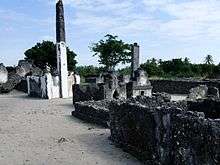Kaole
Kaole is a small town and archaeological site in Tanzania, located three miles east of Bagamoyo on the Indian Ocean coast. The area contains old stone ruins dating to a period between the 13th century and the 16th century, which are the vestiges of an ancient Muslim Shirazi settlement. The archaeological site has two mosques and 30 tombs. One of the buildings is the most ancient known mosque on the Swahili coast. Tombs are built with coral rag, with columns; according to oral history, the diwanis are buried there, i.e., the local sultans, descendants of Ali Muhamad al-Hatim al-Barawi. A small museum has been established, where some artifacts are exposed that were found in the ruins. Some of these artifacts are Chinese and thus provide evidence of ancient commercial relationships between the Shirazi civilization and the Far East.
History

The Shirazi settlement at Kaole was founded in the 13th century, and was called Pumbuji. At the end of the Shirazi Era, Pumbuji declined and was eventually deserted. Later on, the Zaramo people in the area called the place Kaole, meaning "go and see", probably as an expression of wonder and admiration for the buildings left behind by the Shirazi.[1] The Shirazi buildings were gradually ruined by humidity and the advance of mangroves. The first to study the Kaole Ruins was the British archaeologist Neville Chittick, around 1958.
Footnotes
- ↑ Another place, south of Dar es Salaam, has a name with a similar origin: Gezaulole, meaning "try and see".
References
Coordinates: 6°27′48″S 38°56′48″E / 6.4634°S 38.9468°E